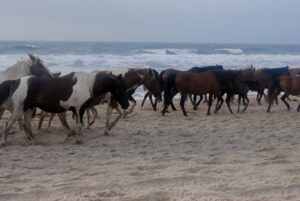While writing the third book in the Dun Cael series, my research involved learning about Iron Age horses. Reading the descriptions of their short stocky legs and shaggy coats reminded me of the ponies on Chincoteague and Assateague Islands on the Virginia/Maryland border. As a young girl, I read Marguerite Henry’s book, Misty of Chincoteague, so many times I could probably quote it.
 Legend has it that these ponies descend from horses that survived the shipwreck of a Spanish galleon carrying Mustangs or Barbary horses in the 16th century. They swam ashore when their ship sank during a storm. While this is an entertaining tale, there is no genetic or archaeological evidence to validate the story.
Legend has it that these ponies descend from horses that survived the shipwreck of a Spanish galleon carrying Mustangs or Barbary horses in the 16th century. They swam ashore when their ship sank during a storm. While this is an entertaining tale, there is no genetic or archaeological evidence to validate the story.
It is more likely that they were brought over by early European settlers in the 17th century who used the islands, which were free of predators, as a natural corral. Another practical benefit of keeping animals there was to avoid taxes by grazing livestock on the islands rather than on the mainland. Examples of this practice include the Hog Island pigs further south as well.
Over the centuries, the ponies have adapted to limited fresh water, drinking brackish water and eating nutrient-poor marsh grasses, which has led to them keeping their small stature and allowing them to thrive in their harsh environment. The ponies are smaller than most breeds today, standing 12-14 hands high (48-56 inches). They have thick necks on their sturdy frame and strong legs. Their hooves have adapted to running in sandy soils. And they are beautiful when they run and frisk along the beaches.
These spirited and gentle animals come in a variety of colors, most of which are pintos; white with black, bay, or chestnut patches. However, they are found in solid colors ranging from gray to black to shades of brown. In the winter, their coat grows thick and shaggy to insulate them from cold winter winds.
Their popularity grew with the release of Misty of Chincoteague in 1947, a tale of determination and overcoming challenges. Paul and Maureen Beebe, two siblings, set out to rescue the mysterious Phantom and her colt, Misty. The children work hard to raise the money to win the mare and her colt at the annual Pony Penning.
The island is split between the states of Maryland and Virginia. The Maryland side is managed by the National Park Service, which maintains a more hands-off approach to the horses. These horses are feral and roam freely, though the Park Service monitors the herd for population control in the fragile Assateague ecosystem.
In Virginia, the ponies are owned by the Chincoteague Fire Department. They maintain a closer eye on the semi-feral herd, provide veterinary care, and employ population control measures.
While controversial to some, the Chincoteague Fire Department hosts the annual pony swim in July, where the herds are rounded up and meet near a narrow crossing to Chincoteague. Though known as the “Pony Swim,” the water is relatively shallow. Once gathered, the first step is their annual check-up with the vet; then, the selected foals are auctioned off to buyers. People come from all over the world to bid on them, and the proceeds provide the annual budget for the fire department and support other charities. Each year, a few foals are bid on to support specific causes. The winners of those will name the horse and release it back into the wild to live out the rest of its life with the herd.
When we lived on the Eastern Shore of Virginia, I volunteered for crowd control during the annual pony swim. My job was to keep the mob of people back as they brought the northern herd down to the crossing. I was given a fact sheet so that I could answer any questions members of the public might have. I was in for a surprise. It turned out I was the one that learned a lot that day. The crowd knew exactly what to do as they placed their chairs behind the ropes along the beach. Then, they eagerly greeted each other and compared notes on which foals they hoped to see that day. They knew not only each one’s parentage but the complete ancestry of every horse. And they recognized each by name as the ponies trotted along the shoreline.
Some came from as far away as California, and listening to them greeting each other, you’d never have known that these people only meet once a year on the sands of these islands to share their mutual interests. The ponies are part of the local heritage. In fact, Beebe Farm, the setting for the book, still exists. But more than that, they have become a symbol of resilience and adaptation, luring people from all over the world to visit and keep their legend alive.

Great article Carol. I know your love of horses, especially loved working the pony swim that year. Maybe some day you get your wish of having one.
I don’t know what we would do with one now. I’ll just have to admire them. 🙂